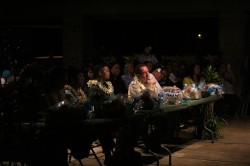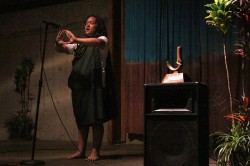A Legacy of Language
As a child, Kilia Purdy-Avelino remembers often listening to her grandfather carrying on effortless conversation with uncles and friends in `Olelo Hawaii, or the Hawaiian language. He was a manaleo, or grew up with Hawaiian as his first language, she said, and although he never passed down the gift to his family, it was always part of her life.
“He was my inspiration to get into Hawaiian language at all,” said Purdy-Avelino. “I made it my goal in life to learn the language and to be able to converse with him.”
However, only two years into her `olelo studies, her grandfather passed away, and in the course of earning her Masters degree in indigenous and culture education at University of Hawaii-Hilo, her goals included a larger mission.
“I pushed to complete my studies to be able to come back and teach it, not just hold it in,” said Purdy-Avelino. “I wanted to make sure the language would live on.”
That was the mission of the first annual `Aha Ho`okuku `Olelo, Hawaiian Language Competition, held Friday evening at Kulana `Oiwi Halau. In celebration of Mahina Aloha `Olelo, Hawaiian Language Month in February, a statewide observance signed into law last year, Molokai held the first language competition the island has seen in generations, according to event co-organizer and emcee, Manuwai Peters.
“It’s way overdue that we have a month dedicated to the Hawaiian Language,” said Peters. “And since this is the last day of Hawaiian Language Month, we’re going to draw out every moment of it!”
Organized by community representatives from each school level, the event showcased more than 50 `olelo speakers of all ages who showcased their skill in two competitions–Ho`opa`ana`au, or memorized verse, and Uluwale — impromptu question and answer — honoring Hawaiian ali`i and the Molokai community.
Showcasing `Olelo Skill
Selected verses were passages spoken by ali`i, which are still used today, such as the Law of the Splintered Paddle — granting protection to those traveling across the islands–recited by keiki in first to second grade. Impromptu questions, geared towards Molokai, required participants to deliver a two-to-four-minute response on a question selected at random.

A judging panel, consisting of six influential individuals in preserving and revitalizing `Olelo in Hawaii, critiqued more than 50 speakers Friday night.
“Learning news words is hard,” said nine-year-old participant, Napua Bicoy, in her fifth year practicing the language. “But I like being able to speak to people in Hawaiian.”
Hawaiian speakers and non-Hawaiian speakers alike enjoyed the event, almost wholly spoken in `olelo.
“Tonight has been wonderful,” said attendee Malcolm Mackey. “My favorite part has been watching the younger kids. I love watching their enthusiasm and…I can see the pride they have in their culture and their language.”
Participants were graded on a point system, which included a greeting; correct memorization and pronunciation; proper inflections, tone and body language appropriate to the language; and closing words for the audience. Highest scoring participants in each category received a various prizes and Hawaiian works of art donated by Na Mea Hawaii, Kamehameha Schools, Blue Monkey gift shop, and others.
“I was surprised by a couple of the kids—just blown away by their expression,” said Kau`i Sai-Dudoit, one of the six judges of the event. “It’s not just remembering the words–they understood it, knew when to pause, when to accentuate. That was important and I was really impressed.”
The highest overall score of the night was awarded a beautiful, hand-carved trophy donated by Molokai wood carver Victor Lopez, and made into the shape of a niho palaoa, a traditional pendant worn by Hawaiian chiefs, representing a tongue to symbolize language, said Purdy-Avelino. The award will serve as the perpetual award each year, adding the name of the previous year’s winner to its center.
Taking home the niho palaoa this year was Purdy-Avelino’s daughter, Kamakaleihiwa Purdy-Avelino, competing in grades nine through 12 age group.
“I feel good,” said Kamakaleihiwa. “I think it’s important for us to carry on the Hawaiian language.”
Returning to the Roots
Although there was one overall winner, everyone who participated and attended were supporters of a larger purpose–to preserve and perpetuate the language, which a one point, was nearly lost, said Purdy-Avelino.

Kamakaleihiwa Purdy-Avelino, competing in grade nine through 12 age group, placed first as the overall highest score in competition. She received a niho palaoa perpetual award, hand-crafted and donated by Molokai wood carver Victor Lopez.
“I went to high school on Oahu and very few people spoke the language because it was forbidden,” said Mackey. “Kamehameha School didn’t even teach the language at that time.”
A U.S. law enacted in 1896 outlawed Hawaiian language to be taught in both public and private schools according to `Aha Punana Leo, a nonprofit serving to revitalize and preserve the Hawaiian language. By 1984, the number of fluent speakers reduced dramatically to only elders and a handful of children. Three years later, after a group of educators came together to discuss the danger of losing the language, it was reintroduced into public schools with the opening of the first elementary school immersion classes, according to the `Aha Punana Leo website.
“I’m so proud, I’m tearing up,” said 17-year-old participant, Apelila Ritte-Camara-Tangonan, who learned `olelo as her first language. “Seeing this tonight was so beautiful, it just captivated me. I’m excited to see how this movement will impact the next generation and how the next generation will hopefully create a whole new era in the Hawaiian system.”
The `Aha Ho`okuku `Olelo served to showcase those preserving the language, but was also meant to inspire others in the Molokai community to do the same.
“For a lot of these participants that went up, they all showed that it’s not just learning the language,” said Purdy-Avelino. “They are showcasing it because it’s their kuleana to now spread it. Hopefully the audience saw that and inspired them to want to learn too.”
For those who found themselves itching at the night’s end to brush up their skills or learn from scratch, there were representatives present to share language-learning opportunities on Molokai.
Some of the resources shared at the event included UH Maui College-Molokai’s introductory and intermediate courses, Kualapu`u school’s beginning classes for parents, as well as the Punana Leo o Molokai cultural preschool for keiki at Lanikeha.
“`Olelo should be something everyone should be offered,” said Maile Na`ehu, instructor for an adult beginning language course at the Keawanui Learning Center. “It’s something that connects us to this aina, to this land.”
After the final pule, Purdy-Avelino said she was pleasantly surprised at the night’s turnout and the overwhelming support of the Molokai community. Thanking Ke Akua for the strength to put on the event, the kupuna who have passed down the `olelo, and her grandfather for instilling the drive to follow in his footsteps, she said this was a great moment for Molokai and for the Hawaiian culture.
“The language doesn’t only live in our schools, it’s already out there in our community, and hopefully one day, we’ll be a Hawaiian-speaking community,” said Purdy-Avelino. “A ola ka `olelo Hawaii — The Hawaiian language shall live on.”























Don't have a Molokai Dispatch ID?
Sign up is easy. Sign up now
You must login to post a comment.
Lost Password